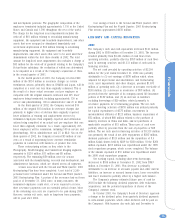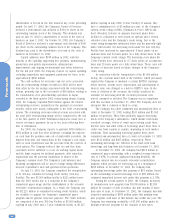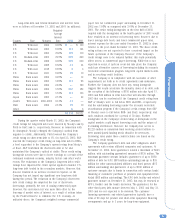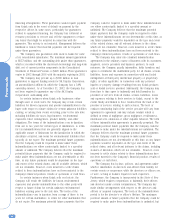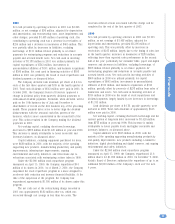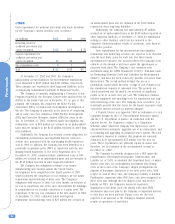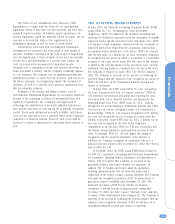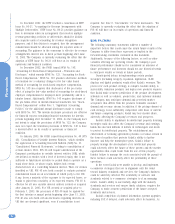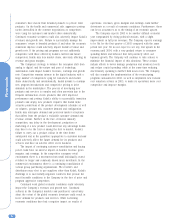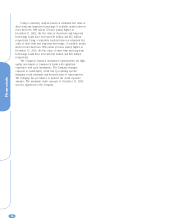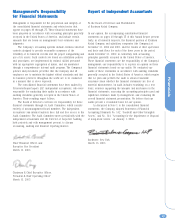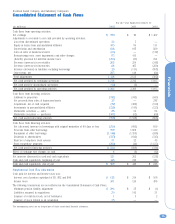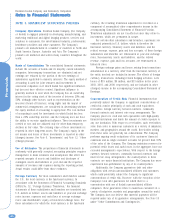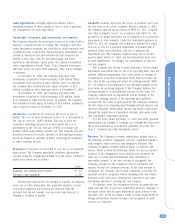Kodak 2002 Annual Report Download - page 35
Download and view the complete annual report
Please find page 35 of the 2002 Kodak annual report below. You can navigate through the pages in the report by either clicking on the pages listed below, or by using the keyword search tool below to find specific information within the annual report.
Financials
35
Kodak continues to expand the planned information services, the
Company must continue to balance the investment of the planned
deployment with the need to upgrade the vendor software.
Kodak’s failure to successfully upgrade to the vendor-supported
version could result in risks to system availability, which could
adversely affect the business.
Kodak intends to complete various portfolio actions required
to strengthen its digital imaging portfolio, rationalize the
photofinishing operations in the U.S. and EAMER and expand its
services business. In the event that Kodak fails to effectively
manage the highly profitable portfolio of its more traditional
businesses simultaneously with the integration of these
acquisitions, and should Kodak fail to streamline and simplify the
business, Kodak could lose market opportunities that result in an
adverse impact on its revenue.
In 2003, Kodak continues to focus on reduction of
inventories, improvement in receivable performance, reduction in
capital expenditures, and improvement in manufacturing
productivity.
Unanticipated delays in the Company’s plans to continue
inventory reductions in 2003 could adversely impact Kodak’s cash
flow outlook. Planned inventory reductions could be compromised
by slower sales that could result from continued weak global
economic conditions. Purchasers’ uncertainty about the extent of
the global economic downturn could result in lower demand for
products and services. The competitive environment and the
transition to digital products and services could also place
pressures on Kodak’s sales and market share. In the event Kodak
was unable to successfully manage these issues in a timely
manner, they could adversely impact the planned inventory
reductions.
Delays in Kodak’s planned improvement in manufacturing
productivity could negatively impact the gross margins of the
Company. Again, a continued weak economy could result in lower
volumes in the factory than planned, which would negatively
impact gross margins. Kodak’s failure to successfully manage
operational performance factors could delay or curtail planned
improvements in manufacturing productivity. If Kodak is unable to
successfully negotiate raw material costs with its suppliers, or
incurs adverse pricing on certain of its commodity-based raw
materials, reduction in the gross margins could occur.
Additionally, delays in the Company’s execution of increasing
manufacturing capabilities for certain of its products in some of
its emerging markets, particularly China where it is more cost
competitive, could adversely impact margins.
Unanticipated delays in the Company’s plans to continue the
improvement of accounts receivable and to reduce the number of
days sales outstanding could also adversely impact Kodak’s cash
flow outlook. A continued weak economy could slow customer
payment patterns. Competitive pressures in major segments may
drive erosion in the financial condition of Kodak’s customers.
These same pressures may adversely affect efforts to shorten
customer payment terms. Kodak’s ability to manage customer risk
while maintaining competitive share may adversely affect
continued accounts receivable improvement in 2003.
In addition, if Kodak is not able to maintain flat capital
spending relative to 2002 levels, this factor could adversely
impact the Company’s cash flow outlook. An increase in capital
spending may occur if more projects than planned were found to
generate significant positive returns in the future. Further, if the
Company deems it necessary to spend more on regulatory
requirements or there are unanticipated general maintenance
obligations requiring more capital spending than planned, the
additional monies required would create an adverse impact on
Kodak’s cash flow.
Kodak’s planned improvement in supply chain efficiency, if
delayed, could adversely affect its business by impacting the
shipments of certain products in their desired quantities and in a
timely manner. The planned efficiencies could be compromised if
Kodak expands into new markets with new applications that are
not fully understood or if the portfolio broadens beyond that
anticipated when the plans were initiated. The unforeseen
changes in manufacturing capacity could compromise the supply
chain efficiencies.
The risk of doing business in developing markets like China,
India, Brazil, Argentina, Mexico, Russia and other economically
volatile areas could adversely affect Kodak’s operations and
earnings. Such risks include the financial instability among
customers in these regions, the political instability and potential
conflicts among developing nations and other non-economic
factors such as irregular trade flows that need to be managed
successfully with the help of the local governments. Kodak’s
failure to successfully manage economic, political and other risks
relating to doing business in developing countries and
economically and politically volatile areas could adversely affect
its business.
In early 2002, the United States dollar was eliminated as
Argentina’s monetary benchmark, resulting in significant currency
devaluation. During the remainder of 2002, the currencies in both
Argentina and Brazil experienced significant devaluation due to
continuing difficult economic times. There can be no guarantee
that economic circumstances in Argentina or elsewhere will not
worsen, which could result in future effects on earnings should
such events occur. The Company’s failure to successfully manage
economic, political and other risks relating to doing business in
developing countries could adversely affect its business.
The Company, as a result of its global operating and
financing activities, is exposed to changes in currency exchange
rates and interest rates, which may adversely affect its results of
operations and financial position.
Competition remains intense in the imaging sector in the
photography, commercial and health segments. On the
photography side, price competition has been driven somewhat by
consumers’ conservative spending behaviors during times of a
weak world economy, international tensions and the accompanying
concern over the possibility of war and terrorism. Some


